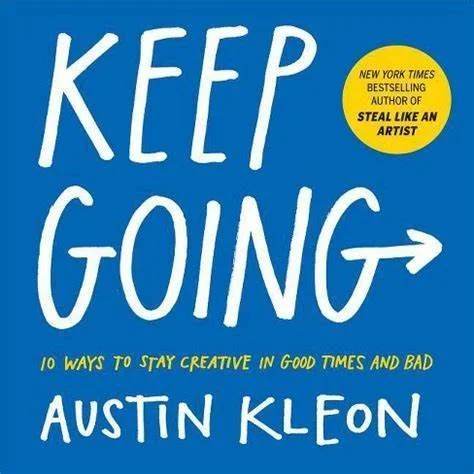A Creative Lifeline: The Book I Didn’t Know I Needed
Keep Going: A Guide to Staying Creative Through Life’s Highs and Lows
Creativity isn’t about waiting for inspiration to strike—it’s about showing up, doing the work, and learning to love the process. In Keep Going: 10 Ways to Stay Creative in Good Times and Bad, Austin Kleon offers a reassuring and insightful guide for artists, writers, and anyone navigating the ups and downs of creative life. It’s a book that acknowledges how difficult it can be to sustain creativity, especially in a world that often feels chaotic, overwhelming, or discouraging. But more importantly, it’s a reminder that persistence, play, and curiosity are at the heart of a meaningful creative practice.
Kleon’s message is simple yet profound: creativity isn’t a destination, it’s a way of life. Unlike his previous books (Steal Like an Artist and Show Your Work!), which focus on generating ideas and sharing them with the world, Keep Going is about endurance—how to continue making art even when motivation fades, doubt creeps in, or external pressures become too loud. He offers ten practical and heartfelt lessons on sustaining creativity, emphasizing that the best way forward isn’t to chase success, but to embrace the daily ritual of making something, anything, without worrying about the outcome.
Some of the book’s most valuable insights include:
Forget the noun, do the verb. Don’t stress about whether you’re a “real artist” or a “successful writer”—just focus on creating.
Make a bliss station. Carve out time and space where you can disconnect from the noise of the world and focus on your work.
Build a routine. Treat creativity like a practice, not a performance. Keep showing up, even when inspiration is nowhere to be found.
Turn work into play. If creating feels like a burden, find ways to bring joy and spontaneity back into it.
Step away from the chaos. The internet and social media can be both inspiring and exhausting. Sometimes, the best thing for creativity is a long walk, a good book, or simply staring out the window.
At its core, Keep Going is a love letter to creative resilience. It’s a reminder that making art isn’t just about talent or inspiration—it’s about commitment, curiosity, and the courage to continue, even when it feels like no one is watching. Kleon doesn’t offer a magic formula to creative success, but he does offer something even more valuable: permission to slow down, enjoy the process, and remember why making art matters in the first place.
For anyone who has ever felt stuck, discouraged, or burnt out, Keep Going is a comforting companion—a voice reminding us that the act of creating is always worth it, no matter the outcome. Because at the end of the day, creativity isn’t about reaching a finish line. It’s about finding joy in the doing, again and again.
Back to the Drawing Board
Reigniting My Creativity: The Power of Playing with Art Again
For a long time, I stopped playing with my art. My full-time job and the pressure of commissions and art shows took over, leaving little room for experimentation or growth. I stuck to what I knew—safe methods that guaranteed success—but eventually, I realized I was stagnating. The thrill of creation was gone, replaced by the stress of deadlines and perfection.
But I decided to change. I carved out time for drawing and painting practice, just for me—no pressure, no expectations. I allowed myself to fail and experiment without the fear of getting it wrong. And that simple shift sparked something incredible. I started to grow again, taking risks in both my personal and professional work. It was liberating to create just for the sake of creating, and it’s reignited my passion for art.
If you’re feeling stuck in a routine, try giving yourself permission to play again. It’s the best way to rediscover your creativity and take your work to new heights.
How I Stopped Playing with My Art—and How I'm Getting It Back
For a long time, I let my art become a task rather than a passion. I work a full-time job, and time is precious. With limited hours in the day, I found myself only creating for shows and commissions—pieces with deadlines and expectations attached. The joy of simply playing with my art, experimenting, and growing as an artist seemed to slip away.
At first, I didn’t notice it happening. I was still making art, after all. But over time, I realized something was missing. I wasn’t pushing my skills, trying new things, or making work just because I felt like it. Instead, every brushstroke felt tied to a purpose outside of myself. Art became another responsibility, not an outlet for self-expression.
Realizing this was a wake-up call. I knew I needed to find a way to balance the necessary work with the personal exploration that keeps my creativity alive. I had to be intentional about making time to practice, experiment, and create freely—without the pressure of an audience or a sale.
So, I built structured drawing and painting practice times into my week. I carved out dedicated hours for honing my skills and exploring ideas that excite me, separate from my commitments to clients and shows. This shift wasn’t easy at first, but it has been transformative. Having this balance allows me to refine my artistic voice, try new techniques, and—most importantly—reignite my love for art.
If you’ve found yourself in a similar place, feeling like your art has become an obligation rather than a passion, I encourage you to reclaim time for play and practice. It doesn’t have to be much—even a few hours a week can make a difference. By nurturing your creative side, you’ll not only improve as an artist but also rediscover the joy that brought you to art in the first place.


